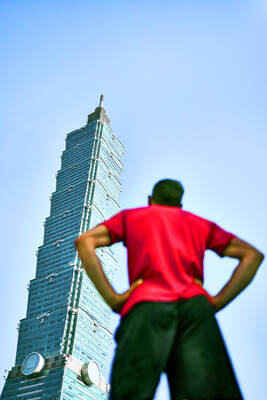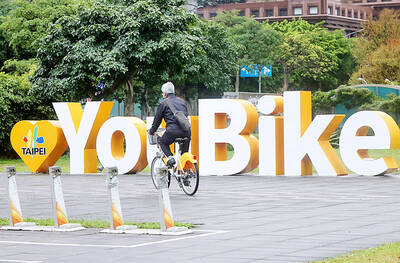When China sailed one of its two aircraft carriers, the Shandong, east of Taiwan proper last month as part of military drills surrounding the island, it was showcasing a capability that it has yet to master and could take years to perfect.
As Beijing modernizes the Chinese People’s Liberation Army (PLA), including its missile forces and naval vessels, such as cutting-edge cruisers, it is posing a concern for the US and its allies.
However, it could take more than a decade before China can mount a credible carrier threat far from its shores, four military attaches and six defense analysts familiar with regional naval deployments said.

Photo:REUTERS
Instead, China’s carriers are more of a propaganda showpiece, with doubts about their value in a possible conflict with the US over Taiwan and about whether China could protect them on longer-range missions into the Pacific and Indian oceans, the attaches and analysts said.
The Chinese National Ministry of Defense did not respond to questions about its carrier program, although dozens of articles in state-linked journals reviewed by Reuters reveal awareness among Chinese military analysts about shortcomings in the country’s carrier capability.
While some regional press coverage, partially based on Chinese state media reports, portrayed the drills around Taiwan as active patrols and a military challenge to the US and its allies, the Chinese carriers are effectively still in training mode, eight of the experts said.

Photo: AFP / Japan’s Ministry of Defense
Landing of aircraft at night and in bad weather, for instance — crucial to regular offshore carrier operations — remain far from routine, several of the attaches and analysts said.
In a conflict, China’s carriers would be vulnerable to missile and submarine attacks, some of the experts said, adding that the Chinese People’s Liberation Army Navy (PLAN) has not perfected protective screening operations, particularly anti-submarine warfare.
“Unlike other parts of their military modernization, there is something politically theatrical about their carrier deployments so far,” said Trevor Hollingsbee, a former British naval intelligence analyst. “Carrier operations are a very complicated game, and China’s got to figure this out all by itself. It still has a long, long way to go.”
At times, China’s carrier pilots have relied on land-based airfields for takeoffs or landings, as well as for extra air cover and surveillance, the attaches said, speaking on condition of anonymity as they were not authorized to speak publicly.
Although China’s Liaoning and Shandong carriers have each sailed into the western Pacific in the past few months, approaching US bases in Guam, they remained within range of coastal Chinese airfields, said Rira Momma, a professor of security studies in Takushoku University’s Institute of World Studies, who reviewed Japanese tracking data.
The Liaoning — a refitted vessel built by the Soviet Union — and the Chinese-built Shandong have jump ramps for take offs, which limit the number and range of aircraft on board.
Anti-submarine helicopters operate from both carriers and China’s Type 055 cruisers, but the carriers have yet to deploy an early warning aircraft, relying so far on land-based planes, the experts said.
A new plane, the KJ-600, designed to perform a similar role to the E-2C/D Hawkeye launched from US carriers, is still in testing, the Pentagon’s latest annual report on China’s military said.
As the Liaoning and the Shandong gradually increase the tempo of their drills, China is preparing for sea trials of its next-generation carrier, the 80,000-tonne Fujian, Chinese state media reported last month.
The Fujian is significantly larger, although conventionally powered, and would launch aircraft from electromagnetic catapults.
The ship, which the Pentagon report said could be operational by next year, is expected to carry new variants of the J-15 fighter jet, replacing an existing model that foreign analysts consider underpowered.
“The Fujian, with its more modern capabilities, will be just another test bed for a good few years,” Singapore-based security analyst Collin Koh (高瑞連) said. “It won’t be until we see the next generation of carriers that the Chinese designs and the PLAN’s intentions will really settle down.”
The carrier program reflects the Chinese Communist Party’s aim to make its forces a “world class” military by 2049, part of Chinese President Xi Jinping’s (習近平) vision of building “a great modern socialist country.”
The attaches said that one indication of China’s ambitions would be if carriers built after the Fujian are nuclear-powered, like US ones, allowing a global range.
A study published in December by the nonpartisan US Congressional Research Service said that China would use its carriers to project power “particularly in scenarios that do not involve opposing US forces” and “to impress or intimidate foreign observers.”
Several countries operate aircraft carriers, but the US remains the most dominant, running 11 carrier battlegroups with global reach.
China, by contrast, could use its carriers primarily in the Asian theater, working in tandem with submarines and anti-ship missiles to attempt to control its near seas.
The Shandong’s appearance off Taiwan’s east coast to stage mock strikes last month surprised some analysts, given the nation’s proximity to land-based airfields.
However, in the short term at least, the military would struggle to defend the carrier out in the western Pacific in a clash with US and allied forces, the analysts said.
“China’s objective with the deployment of the Shandong is clear. It is a symbol of its political anger” over US engagement with Taiwan, former Japanese Self Defense Fleet commander Admiral Yoji Koda said.
In a battle, it “would be a very good target for US and Japanese forces, and they would take it down at the very beginning,” he said.
A US defense official, speaking on the condition of anonymity as they were not authorized to talk publicly, said while China had made progress with its carriers, it had yet to master operations in difficult conditions or how to protect the vessels.
One question was how the ships would be relevant in a conflict, the official said.
Chinese military and government researchers appear aware of the challenges, according to a Reuters review of more than 100 recent articles published in dozens of publicly available Chinese defense journals.
Chinese military news Web site PLA Daily in October last year published an interview with an aircraft carrier aviation unit in which its deputy chief of staff acknowledged “many shortcomings in preparing for war” and a gap between sailors’ training level and combat requirements.
An editorial published in September last year in a magazine run by a Chinese weapons manufacturer, titled “Four great advantages the PLA has in attacking Taiwan,” did not mention the role of Chinese carriers.
Instead, it said that China’s land-based ballistic missiles would be enough to overwhelm a potential intervention from US carriers.
Two earlier editorials in the same publication, Tank and Armored Vehicle, said that Chinese carriers would remain in their infancy for the foreseeable future and that other surface ships would be more useful in a conflict in the East China Sea.
Other articles in similar publications outlined pilot recruitment and training problems, vulnerabilities to submarine attack and command issues, which some foreign analysts say are a problem for a navy that still sails with political commissars with executive authority.
When at sea, US carriers fly almost constantly, routinely operating fighter, electronic-warfare and surveillance aircraft to create a protective screen around the battlegroup.
Beyond the expense and danger of such operations, one key element is mastering devolved command systems, particularly in a crisis such as a fire or crash onboard when planes are airborne and the flight deck is disabled.
The US has spent decades perfecting such systems, having expanded carrier operations after their importance was highlighted in the Allied victory over Japan in the Pacific in World War II.
In the medium term, China is likely to start sending battlegroups into the Indian Ocean, where China’s presence is minimal beyond routine submarine operations, the attaches and defense analysts said.
Operating far from the security of land-based airfields would test China’s capability, but preparations are underway.
The pier at China’s first major offshore military base in Djibouti was recently extended to fit a carrier, the Pentagon report said.

US climber Alex Honnold is to attempt to scale Taipei 101 without a rope and harness in a live Netflix special on Jan. 24, the streaming platform announced on Wednesday. Accounting for the time difference, the two-hour broadcast of Honnold’s climb, called Skyscraper Live, is to air on Jan. 23 in the US, Netflix said in a statement. Honnold, 40, was the first person ever to free solo climb the 900m El Capitan rock formation in Yosemite National Park — a feat that was recorded and later made into the 2018 documentary film Free Solo. Netflix previewed Skyscraper Live in October, after videos

Starting on Jan. 1, YouBike riders must have insurance to use the service, and a six-month trial of NT$5 coupons under certain conditions would be implemented to balance bike shortages, a joint statement from transportation departments across Taipei, New Taipei City and Taoyuan announced yesterday. The rental bike system operator said that coupons would be offered to riders to rent bikes from full stations, for riders who take out an electric-assisted bike from a full station, and for riders who return a bike to an empty station. All riders with YouBike accounts are automatically eligible for the program, and each membership account

NUMBERS IMBALANCE: More than 4 million Taiwanese have visited China this year, while only about half a million Chinese have visited here Beijing has yet to respond to Taiwan’s requests for negotiation over matters related to the recovery of cross-strait tourism, the Tourism Administration said yesterday. Taiwan’s tourism authority issued the statement after Chinese-language daily the China Times reported yesterday that the government’s policy of banning group tours to China does not stop Taiwanese from visiting the country. As of October, more than 4.2 million had traveled to China this year, exceeding last year. Beijing estimated the number of Taiwanese tourists in China could reach 4.5 million this year. By contrast, only 500,000 Chinese tourists are expected in Taiwan, the report said. The report

Temperatures are forecast to drop steadily as a continental cold air mass moves across Taiwan, with some areas also likely to see heavy rainfall, the Central Weather Administration (CWA) said. From today through early tomorrow, a cold air mass would keep temperatures low across central and northern Taiwan, and the eastern half of Taiwan proper, with isolated brief showers forecast along Keelung’s north coast, Taipei and New Taipei City’s mountainous areas and eastern Taiwan, it said. Lows of 11°C to 15°C are forecast in central and northern Taiwan, Yilan County, and the outlying Kinmen and Lienchiang (Matsu) counties, and 14°C to 17°C